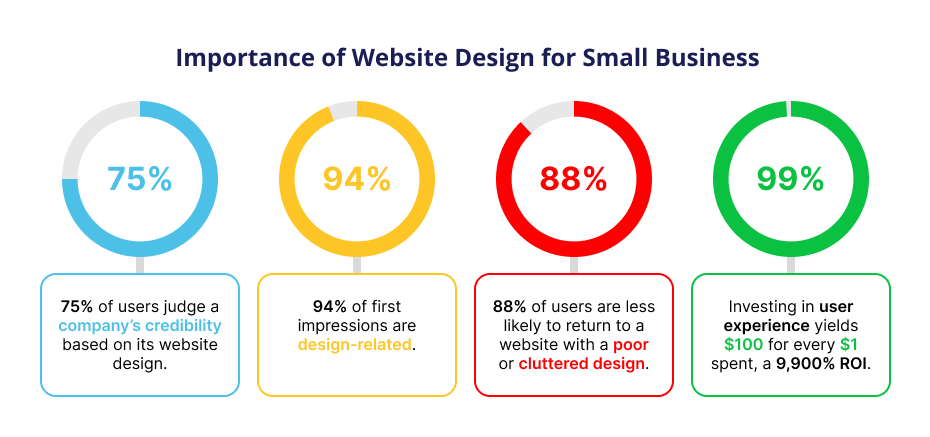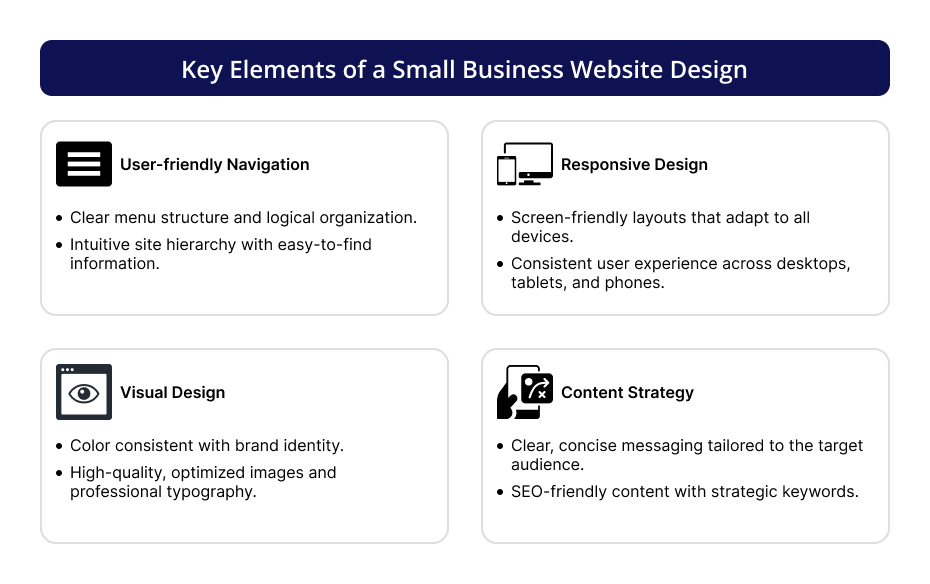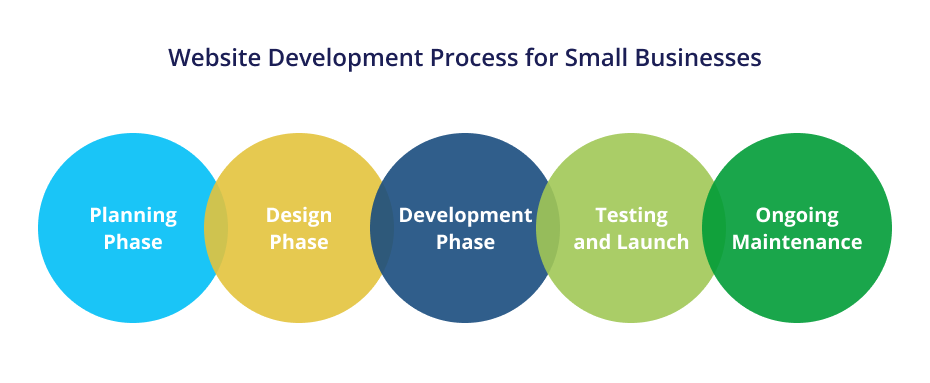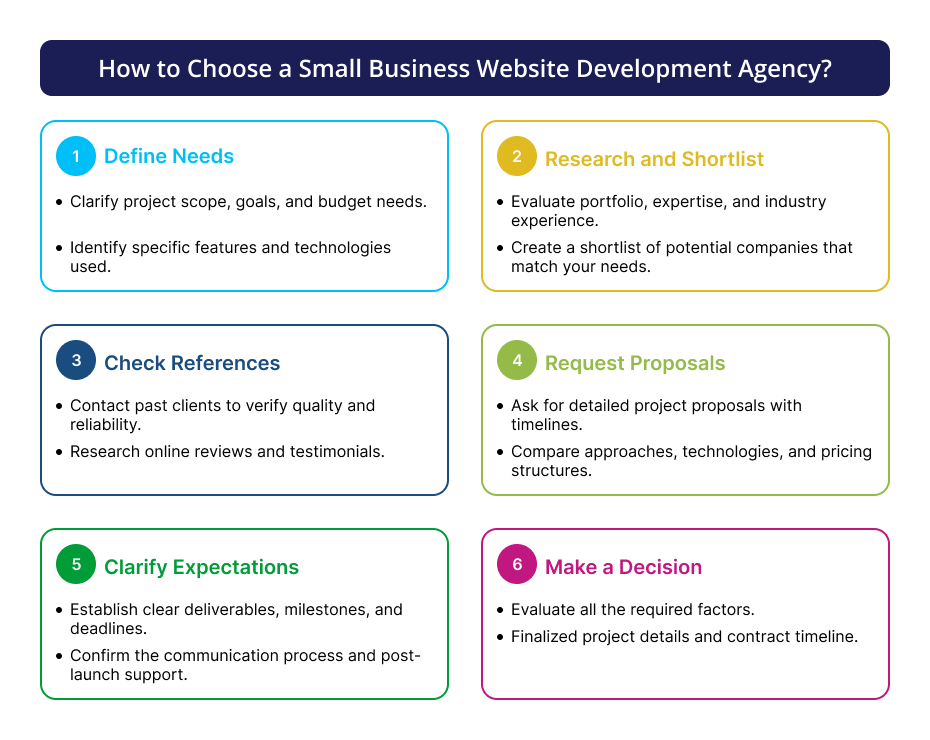A website is far more than just a digital placeholder for US small businesses. It’s an essential driver of trust, revenue, and visibility, playing a crucial role in influencing customer decisions. Studies also state that 81% of consumers conduct online research before purchasing. This highlights the essential role a website plays in shaping shoppers’ buying decisions.
A professionally designed website does more than just improve the visual appeal; in fact, it strengthens your brand presence and boosts sales. For small businesses in the US, having a well-designed website has become a necessity. Yet, 27% of small businesses in the USA operate without a website, missing out on numerous opportunities to connect with potential clients.
However, simply having a website is not enough. Building an online presence that performs and delivers results requires strategic planning that covers the essential elements of success. That’s why entrepreneurs increasingly turn to professional website design services to ensure their web presence remains success-optimized.
Importance of Website Design for Small Businesses
Website design is crucial for small businesses in shaping their digital presence. A thoughtfully designed website is more than a visual asset in a competitive landscape where every click can lead to a sale or a lost customer. A visually appealing website design is about strategic layout, intuitive navigation, and responsive functionality that relates to the target audience of a business.
When done correctly, it enhances the user experience and fosters trust, leading to increased conversions and customer loyalty. Warby Parker is an example that has revolutionized the approach to design and development of small business websites. The intuitive navigation, clutter-free design, and clear calls to action have transformed the online shopping experience for users.
Statistics Highlighting the Importance of Small Business Web Design
Web design is as much about function as it is about form. A small business website design is all about strategically placing elements and conveying a clear message to users. Here are some stats that showcase why website design is essential:
- 75% of users judge a company’s credibility based on its website design.
- 94% of first impressions are design-related.
- 88% of users are less likely to return to a website with a poor or cluttered design.
- Businesses that invest in user experience see a return of $100 for every $1 spent.
These statistics demonstrate the importance of an aesthetically pleasing design. Investing in quality UI/UX design services empowers a small business to stay competitive.

The Pros of an Excellent Small Business Website Design
An excellent website design for small businesses is not just optional, it’s a core component of success in the real market. A well-crafted, business-specific website creates a strong first impression, engages potential customers, and enhances your brand presence. Here are the key advantages of investing in a business-specific website design:
-
Helpful in Building Credibility
A well-structured site design conveys to customers that a business is legitimate and trustworthy, especially crucial for first-time visitors. Working with a corporate website design company can significantly help in achieving this goal.
-
Boost Conversion Rates
Clear navigation, strategically placed CTAs, and an intuitive layout help guide visitors towards an organization’s goal, which can be either the purchase of a product, booking, or contacting.
-
Improve User Experience
Crafting a positive user experience is essential for any website, as it directly impacts visitor engagement and satisfaction. A well-designed website removes friction, and web design services for small businesses can help deliver that. Visitors can browse seamlessly across your website and engage with the content or product without any frustration.
-
Strengthens Your Brand Identity
A small business website design should be visually cohesive and helpful in improving brand recognition and trust. This plays a crucial role in enhancing brand identity by fostering customer loyalty.
Key Elements of Small Business Website Design
A website design is what users interact with first; it should be clear, compelling, and related to the purpose of a business. Here are some key elements not to miss in the process of small business web design:

-
User-friendly Navigation
Organize the website with a clear, simple, and logical structure. Use a simple menu to enable users to quickly find information and products. Also, focus on maintaining a consistent small business website design across all pages.
-
Responsive Design
Your website should be screen-independent, meaning it adjusts seamlessly to different layouts without losing its essence. Websites with responsive design lead to higher mobile traffic by improving 11% higher conversion rates.
-
Visual Appeal
Website design for small businesses is significantly influenced by its visual appeal. First impressions always matter, and implementing colors, fonts, and images that relate to your brand is crucial.
-
Content Strategy
An entrepreneur must focus on crafting clear, concise, and compelling content that precisely communicates the value proposition. Additionally, regular updates and adherence to SEO best practices ensure the site’s visibility on search engines, leading to increased lead generation and sales.
-
Exceptional Mobile Usability
When it comes to web design for small businesses, it is essential to consider every screen size when designing a site. Also, design navigation elements that are easy to tap and interact with on diverse screen sizes, minimizing user frustration.
Must-Have Small Business Website Design Features
Competition in the market is evident, and its consideration is essential when implementing website design for small businesses. Design lays the foundation, and features set the tone for the user experience and functionality. In 2025, a small business must include modern features to stay relevant and competitive:
-
AI Integration
Artificial Intelligence is a transformative technology that helps businesses maximize their potential today, regardless of their size. Small businesses can enhance their operations by implementing AI-specific features through AI integration, thereby improving user engagement, efficiency, and driving informed decision-making. This can be done through either:
- AI-first chatbots
- AI-driven personalization
- Content generation
-
Interactive Elements
Engaging users with interactive elements is one of the key strategies in small business website design that translates to a better customer experience and encourages them to spend more time on the site. Consider including:
- Quizzes
- Surveys
- Interactive product displays
- Live chat
- Product customization tools
-
Data Analytics Integration
Integrate tools to track user behavior (heatmaps, click-through rates), site performance, and conversion tracking. This data provides valuable insights for refining your strategies and improving user experiences.
-
Include Social Sharing Buttons
One key strategy for designing a small business website is to incorporate the business’s social media presence. Add social sharing buttons on the content, allowing users to easily share articles or products on their social media handles. This will translate to amplify the reach by driving traffic to the site.
-
Voice Search Optimization
In 2025, voice search is popular among users, making it a smart move to optimize a website for this innovative feature. One must consider utilizing key small business web design strategies that include:
- Optimizing site content for voice search by using natural language and conversational phrases through long-tail keywords. This aligns with how users typically speak when using voice assistants.
- Implement structured data markup to help search engines better understand your content, increasing the chances of appearing in voice search results.
Best Practices to Follow For Small Business Website Design
A well-designed website is an effective way for businesses to establish credibility among users and build new revenue models. By adhering to best practices in small business website design, one can create an online presence that communicates the brand’s message and engages with the audience. Here are the precise ones to follow:
-
Create a Website Design Plan
Start by identifying the primary objectives of the website, whether to generate leads or provide information. A clear understanding of goals and audience will guide a small business to build a website design plan that revolves around its needs.
-
Remove Unwanted Elements
A well-designed website can make all the difference in attracting and retaining new customers. To ensure your business stands out, you can hire web designer to curate a user-centric wireframe to visualize the layout and structure of the site. Consider including necessary elements and avoid cluttering web pages with irrelevant images or texts.
-
Focus on Mobile-First Design
One must focus on the importance of small screens while designing a site. Adopt a mobile-first approach by designing for smaller screens and scaling up for larger devices. Design buttons and links that are easier to tap on mobile devices, ensuring a seamless user experience across diverse devices.
-
Implement Correct Typography
Typography plays a crucial role in the small business web design process. One must select fonts that are easier to read across different screens, establish a clear visual hierarchy to capture the user’s attention, highlight important information, and maintain consistency throughout the site for a cohesive look.
Small Business Website Design and Development Trends to Follow
The digital transformation wave has led small businesses to invest in website development. It becomes quintessential for them to stay relevant and competitive in the market, including their need-specific design and development trends. Here are the key trends that a small business can make the most of:
-
Minimalist Design
The minimalist design emphasizes simplicity in web page design, avoiding clutter and utilizing a limited color palette to create a professional-looking user interface.
-
AI-Powered Personalization
AI enables small businesses to deliver personalized experiences, from tailored content to product recommendations, based on user behavior, preferences, and demographics.
-
Parallax Scrolling
One of the website design trends for small businesses is Parallax Scrolling. This creates a 3D effect as users scroll down the page by moving background images at a speed different from foreground content.
-
Progressive Web Apps
Small business website design and development strategy includes targeting mobile users, and PWAs are one of the trends that combine the best features of web and mobile applications.
-
AR/VR Integration
The integration of AR/VR enables users to interact immersively with products, such as trying on clothes virtually or visualizing furniture in their own homes.
Trends and Their Impact on the Growth of Small Businesses
| Trends | Impact | Examples |
| Minimalist Design | Improves user experience and engagement by reducing clutter. | Websites like Apple, Dropbox, and more utilize this trend |
| AI-Powered Personalization | Increases user engagement by tailoring content and product suggestions | Amazon is a popular example |
| Parallax Scrolling | Adds visual appeal and depth to the small business web design | Nike uses parallax scrolling for an immersive experience |
| Progressive Web Apps | Progressive web app development improves performance and accessibility | Pinterest is one such example |
| AR/VR Integration | Enables interactive product experiences, increasing buyer confidence | Home Depot and Snapchat for business are some of the examples |
Step-by-Step Process of Website Development for Small Businesses
While web design sets the foundation, the development phase brings it to use. A structured web development process ensures the final product stays functional, user-friendly, and aligned with business goals. It is necessary to understand the different stages of website development. Here is the agile approach you must follow throughout the process.

-
Planning Phase
The planning phase is critical for developing a well-structured site. It lays the foundation for a positive user experience, seamless functionality, and cohesive website design. The key activities include:
- Website’s purpose and goals
- Researching competitors
- Outlining key features required
- Creating a sitemap
- Establish a realistic timeline and budget
-
Hire Trusted Website Design and Development Service Provider
Once you have a clear plan, it’s essential to hire a trusted website design and development agency. Look for companies with experience in your industry and a strong portfolio demonstrating their ability to create user-friendly and visually appealing websites. A reliable partner will help you navigate the complexities of the development process and ensure that your website aligns with your business goals.
-
Design Phase
Website design must include the elements, features, and specifics that relate to the business’s requirements. The process can be complex, and it is wise to hire website designers for small businesses to align the homepage and key inner pages, which are designed using brand-aligned colors, fonts, and images.
-
Development Phase
Once the design is finalized, the development phase commences, where skilled developers translate the visual blueprint into a functional and interactive website. This process involves the use of custom web development technologies to build the frontend, backend, and integrate the database and API, ensuring optimal functionality and a seamless user experience.
-
Testing and Launch Phase
Before going live, the site undergoes several testing processes to ensure no bugs or errors remain. This includes checking for broken links, bugs, cross-browser compatibility, performance, and usability testing. Once the quality assurance team approves, the website is ready for launch.
-
Ongoing Website Maintenance
Regular updates to code, content, and design are essential for optimizing website performance. Ongoing website maintenance should prioritize implementing security measures, ensuring compliance, and enhancing performance based on user feedback.
Choosing the Right Platform for Website Development for Small Businesses
Selecting your need-specific platform is a critical decision in the website development journey, especially for small businesses. The ideal CMS should strike a balance between ease of use, cost-effectiveness, scalability, and flexibility. Below is a comparison of the three leading CMS platforms to help you make the right decision:
| Feature | WordPress | Wix | Shopify |
| Best for | Blogs, business sites, and portfolios | Creative professionals and portfolio | Ideal small business-specific eCommerce platform |
| Ease of Use | Moderate (requires WordPress developers assistance for advanced customization) | Easy to use with drag-and-drop functions | Comparatively easier to use than other eCommerce platforms with a drag-and-drop feature. |
| Customization | Highly customizable themes and plugins | Limited customization | Moderate customization (advanced customization requires Shopify developers assistance) |
| Cost | Free core, hosting ($5 to $15/month) | Free to plan-specific costings. Starting from $17/month to $159/month | Freemium platform, starting from $5/month to $399/month, depending on the chosen plan |
| eCommerce Features | Requires a plugin, like WooCommerce | Basic eCommerce functions | Built specifically for eCommerce |
| SEO Capabilities | Excellent with plugins | Good | Good (built-in support for SEO) |
Key Considerations in Website Development for Small Businesses
Designing a website is one phase, development is another. But what truly makes a website valuable for driving business outcomes is how effectively it integrates form and function to achieve the goals of a small business. A website doesn’t just look good; it performs well, builds trust, and drives growth.
-
Clear Purpose
A website with a clear purpose effectively communicates and achieves the desired business outcome. This helps in several ways, including defining success metrics, streamlining the small business website development process, and ensuring the website effectively delivers its intended message.
-
Consistent Branding
A professional website reinforces a brand’s identity. This includes the usage of consistent colors, fonts, and logo placement. Additionally, the effective use of visuals to demonstrate the unique appeal of a business.
-
Social Proof
People trust businesses that others trust. Adding social proof to a small business’s website enhances its credibility through numerical evidence that demonstrates expertise, positive media mentions, and the display of industry awards.
-
Clear Sitemap
A key aspect of website development for small businesses is creating a clear and logical navigation structure. This consists of a logical grouping of the menu structure, a footer that indicates clickable links, and the use of breadcrumbs.
-
Testimonials
Including real feedback from customers can influence new and potential customers to put trust in the products or services a business offers. This includes video testimonials, story highlighting, or more.
-
Performance Monitoring
Website launching is not the last step; it may be a crucial part of website development for small businesses, but it’s the beginning of ongoing improvement. To track the performance utilization of specific tools, monitor loading speed, bounce rates, and other issues, and promptly identify and resolve them.
How Much Does Small Business Website Development Cost?
The cost of website design and development for small businesses depends entirely on the design’s complexity, the number of pages, the features required, the platforms selected, and the experience of the hired team. However, for small businesses looking to build eCommerce sites, it can be relatively more expensive due to the addition of extra features that translate into a seamless shopping experience.
Here’s a tabular representation of the cost:
| Website Type | Design Cost (USD) | Development Cost (USD) | Total Estimated Cost (USD) |
| Basic Website (3–5 pages) | $200 – $700 | $500 – $1,000 | $600 – $1,200+ |
| Standard Website (5–10 pages) | $700 – $1,400 | $1,000 – $1,800 | $800 – $2,200+ |
| Custom website development | $1,500 – $2,800 | $2,000 – $4,500 | $2,500 – $8,000+ |
| Basic eCommerce site | $500 – $1,500 | $1,200 – $2,800 | $600 – $3,000+ |
| Advanced eCommerce website | $1,000 – $2,500 | $3,000 – $8,000+ | $4,200 – $18,000+ |
Note: The table demonstrates an approximate cost of designing and development. For more affordable web design for small businesses, specific requirements and features play a crucial role in determining the final cost.
Common Mistakes to Avoid in Small Business Website Design & Development
When creating a website, it is essential to be aware of potential pitfalls to save time, resources, and frustration. By understanding common mistakes, small businesses can ensure a smoother design and development process, leading to a more effective online presence. Here are some key mistakes to avoid:
-
Ignoring Mobile Optimization
Today, most website traffic comes from mobile devices. A success-focused small business website design strategy must prioritize mobile-first designs. Every screen-optimized website can translate to lower bounce rates.
-
Overloading with Plugins
While plugins add an extra layer of functionality, including too many of them can slow the speed of your site, create compatibility issues, and make future updates more complex.
-
Poor-Quality Images
Low-quality or poorly created images can negatively impact a small business’s online presence. Instead, utilize high-quality visuals that precisely reflect the message of your brand.
-
Neglecting Security
Building a secure website is crucial for a small business to make a positive and credible presence among users. With increasing concerns about data privacy and security, adhering to regulations like the GDPR is essential.
How to Choose Your Project-Specific Small Business Website Development Agency?
Development requires a structured approach, and picking a B2B website design company without inquiring is inefficient. Hence, a US-based small business entrepreneur must follow a thorough approach to find a skilled agency to work on their project. The process includes:

-
Define Project Needs
Clarify the needs of your project by documenting the questions that are required for it. This includes:
- What specifically do you want in your project?
- Do you require theme-based or custom web development?
- What features do you require in your project?
- How much time do you want your project to be live?
These will set the tone for the subsequent steps you will take.
-
Research and Shortlist
Based on the project requirements, look for experienced companies with expertise specific to your project. Review their portfolios or case studies to understand the projects they’ve completed, the trends they’ve followed, and the efficiency of their development processes. From this, shortlist the most suitable ones.
-
Check References
As an entrepreneur, avoid making decisions in haste. Verify the website development service provider’s reputation, history, and customer satisfaction over platforms like Clutch, TrustPilot, Crunchbase, and more. This will shorten your list and help you keep only the best potential service providers.
-
Request Proposals
You can request detailed cost proposals with timelines from the shortlisted small business web design and development service providers. Interview them and compare their offerings, pricing, and terms by keeping your budget and project expectations aligned.
-
Clarify Expectations
The previous step will help you narrow down this list to the best potential service providers. Now, clarify the expectations of your project by confirming all the aspects of the service, including Service Level Agreements (SLAs) and support.
-
Make a Decision
This process can be time-consuming, but it helps you find a skilled company for your project. Choose the small business website development service provider that best aligns with your needs and priorities.
Factors to Consider While Finding a Small Business Website Development Partner
What aspects must be considered when looking for an expert website design and development service provider? The answer to this question revolves mainly around a business’s specific needs. Here are the factors that an entrepreneur must consider in 2025:
-
Experience and Expertise
After clarifying specific project needs, look for experienced small business web development companies with a proven track record in your domain. A service provider’s website or its social presence advocates not only for its experience but also for its expertise in the specific technologies relevant to your project.
-
Range of Services
How versatile is a small business website design and development company? Check whether they offer a wide range of services. Ensure that an expert team covers the service you require or can seamlessly integrate with other services you might use.
-
Quality Assurance Support
You must evaluate whether an IT partner provides quality assurance support. Evaluate things like SLAs, customer-level support, web testing strategies they use, and more to find a skilled team for your project.
-
Cultural Fit
Do website designers for small businesses share similar values and understand your business culture? A good cultural fit can definitely lead to better collaboration and a productive working relationship.
-
Communication
Effective communication is a key pillar of the website development process. Ensure that the small business website development partner is transparent about their process, timelines, pricing, and potential changes.
Conclusion
This blog covers every notion an entrepreneur in 2025 will acquire and implement to build a top-tier small business website. The potential of the online market is widely evident, and among the 27% of US-based small businesses still lacking a website, there’s a clear opportunity to gain an edge through strategic small business website design and development.
By following the best practices, a small business will not only avoid costly mistakes but can also implement project-specific trends. While getting started independently is possible, partnering with experienced professionals can ensure that your website meets technical, aesthetic, and performance standards.
Why Choose SparxIT for Small Business Website Design and Development?
SparxIT, a leading web development company, offers our clients the assistance they need to generate new revenue streams. With years of experience in the industry, our team has served a diverse range of clients worldwide, from small businesses to enterprises, providing modern web solutions.
Our team stays up-to-date with the user-focused trends, including AI, IoT, AR/VR, Blockchain, and more, in web development and integrates them according to users’ requirements. Our forward-thinking team adapts to new technologies while also being client-focused.
Partner with us to collaborate with some great minds in website design and development.

Partner with Experts
Frequently Asked Questions
How much does it cost to design and develop a small business website in the U.S.?






The cost of a small business website design and development in the US typically ranges from $10,000 to $20,000 or more, depending on the complexity and specific features. Contact us to know the precise details about the cost.
How long does it take to build a small business website?










The small business website development typically takes three to four months or more, depending on the website's type, complexity, and the features you want to include.
What industries does SparxIT serve for small business website development?










We serve a wide range of industries for small business website development, including finance, real estate, logistics, eCommerce, travel, SaaS,and more.
What technologies are best for small business website development in 2025?










Popular choices include WordPress, Wix, and Shopify for ease of use, while modern frameworks like React, Vue.js, and Django offer flexibility and scalability for more custom websites.


